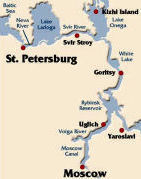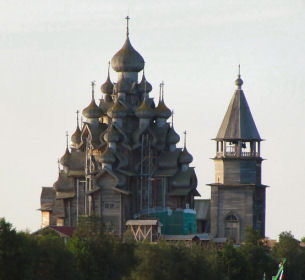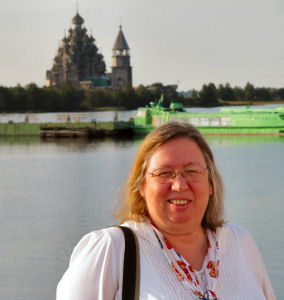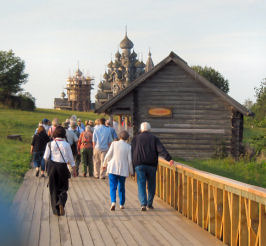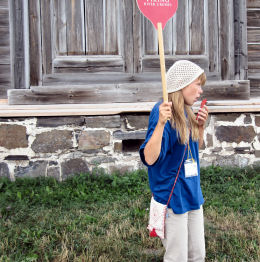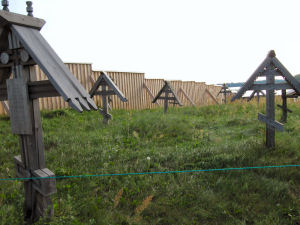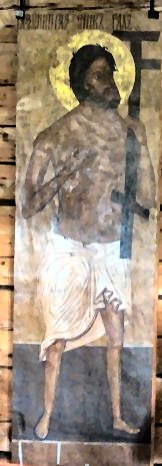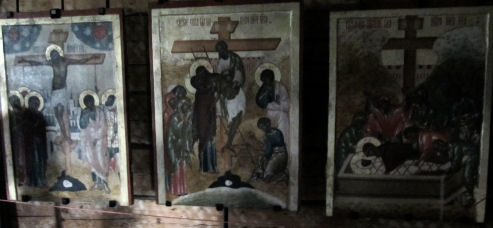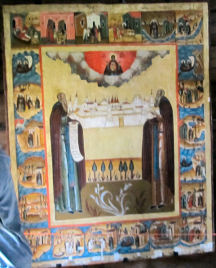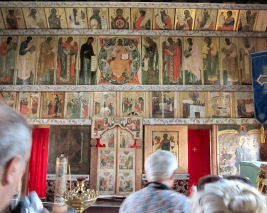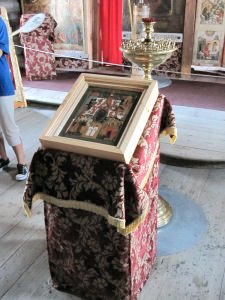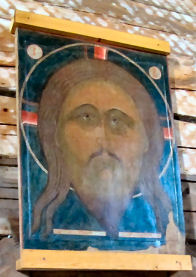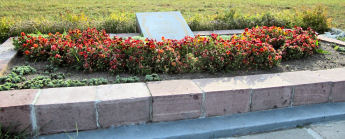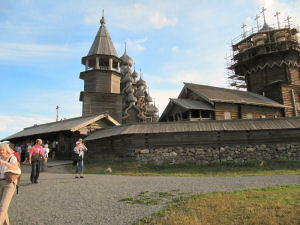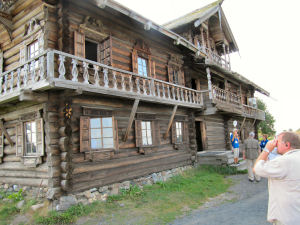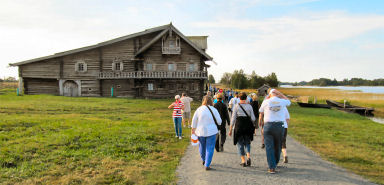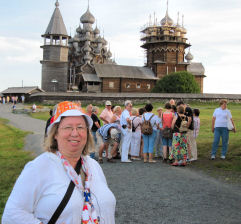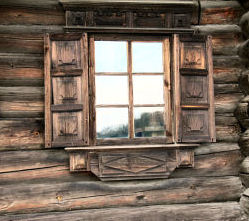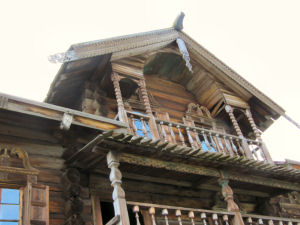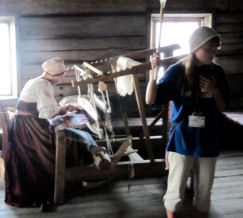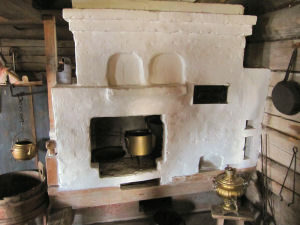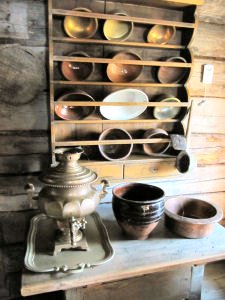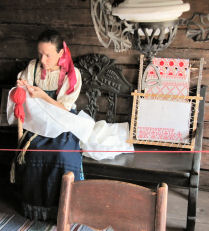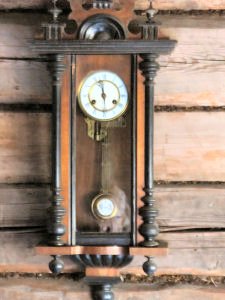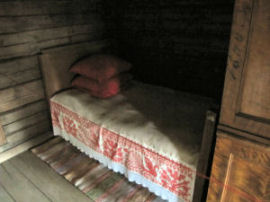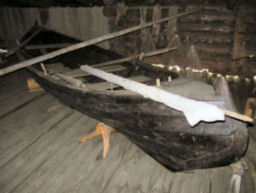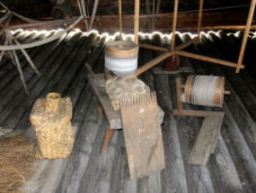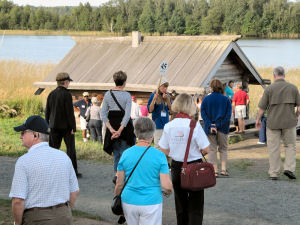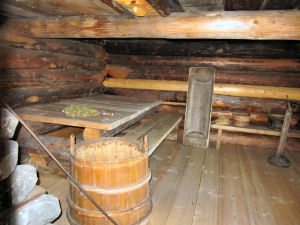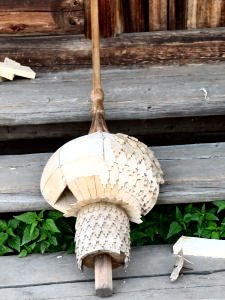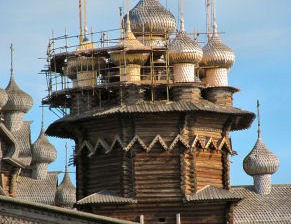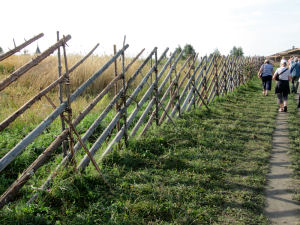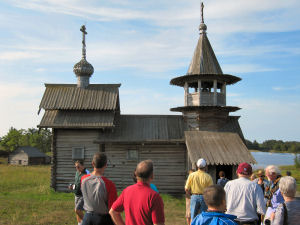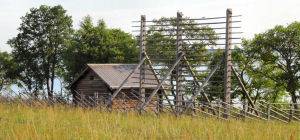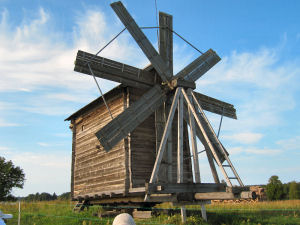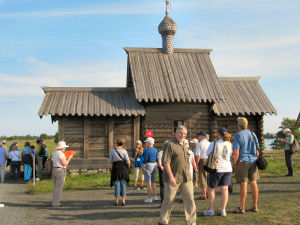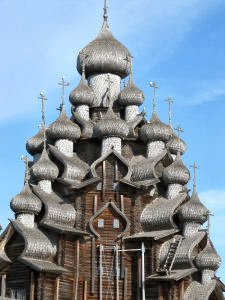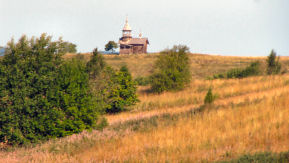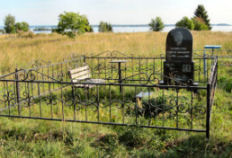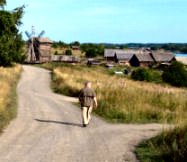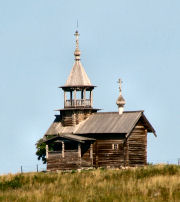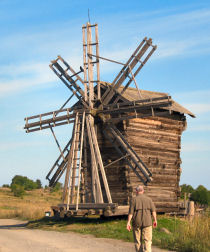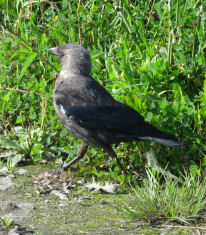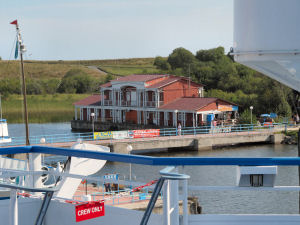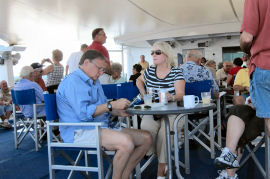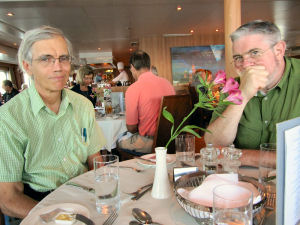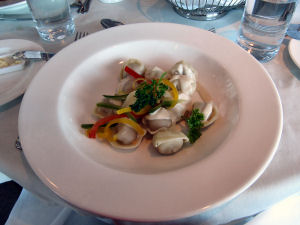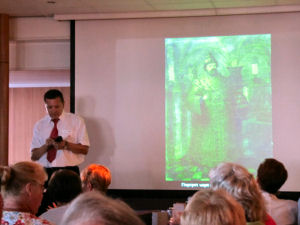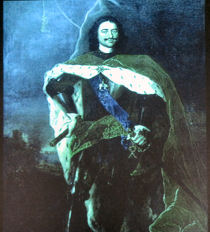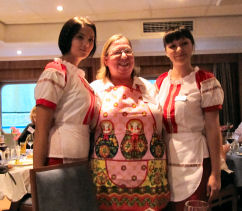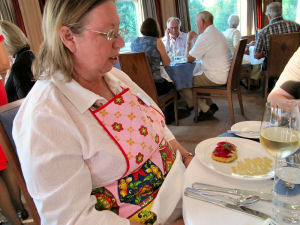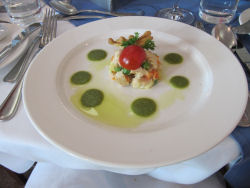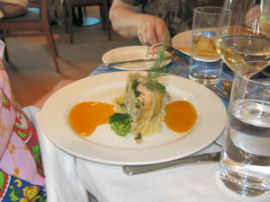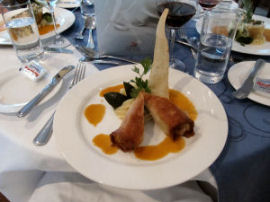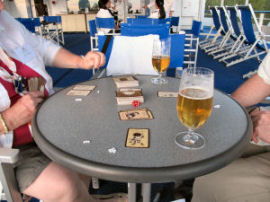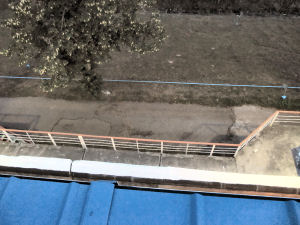I had not checked my e-mail in a few days. Because the wireless reception was a little better in the library, I set up camp there. I received a disconcerting e-mail from my business partner, Denise, explaining that my dad had been experiencing computer problems. His display would just go blank after a few seconds every time that he turned it on. Denise talked him through trying a few things, but nothing seemed to help.
I did not know what to suggest that she try. My dad had poor vision, and even when his eyes both worked, he was not very good at using the computer or any other machine for that matter. If his computer did not get fixed, I would not be able to communicate with him for the rest of the trip. I would have to try to think of a plan and relay it to Denise to execute. The downloading of my business e-mail seemed to be timing out. One of the messages probably had a large attachment. While I waited for the download, I worked on my journal. After only a few minutes of this I began to feel queasy. The library was in the middle of the ship and had no windows. Fortunately, the cabin was not very far away. Shortly after I entered, I started to get nauseous. Since Sue was in bathroom, I availed myself of an empty plastic bag. I got sick once more that morning, but that time I had access to the bathroom. I had to admit that I must not have been as good a sailor as I thought that I was. This never had happened to me on a sea cruise, and on one occasion we had confronted fairly heavy seas in the Caribbean.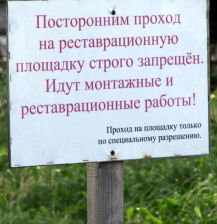
The people on bus #45 stayed together for the first part of the visit. Polina introduced us to our local guide, a short blonde young lady named Elena. She explained that the entire island, which was approximately one kilometer wide and six long, was an open-air museum. Smoking was strictly prohibited on the island except in a few designated locations. The local people were seriously worried about fire. It sounded preposterous, but there were supposedly vipers, which were definitely poisonous. Boardwalks were put in place in some locations so that unwary tourists did not step on one. “Romanoff”
Elena recited a short history of the island. Her English was pretty good, but it was obvious that she had memorized her spiel. She used the term “Zaonegia,” or something like that, to refer to the area. I was not sure exactly what the word was, but I think that she was referring to the area in and around Lake Onega. She said that pagans inhabited the island first. Russians came here from Old Novgorod in the fourteenth century at the latest. I wrote down that she said that it was north of St. Petersburg, but the current city of Veliky Novgorod is due south of St. Petersburg. The area of Lake Onega had always contained an abundance of animals and pearls. The Russian culture and the native culture mixed together on Kizhi.The biggest attraction of the island was the Church of the Transfiguration, an elegant wooden structure that was clearly visible from quite a distance away. The local legend claimed that it was built by one man who threw his axe into the lake when he was finished. More likely a team constructed it without written plans in the seventeenth century. Very few nails were employed in its construction. It stood forty-seven meters tall with twenty-two domes, a very peculiar number.[1] The domes helped to protect the sides of the church from damage from water.
The interior of the church was closed in 1982 because of structural damage and tilting. Scaffolding was in evidence on every side of the church, but no one seemed to be working on it.[2] Restoration had been going on since 2003.Next to the church was the much smaller Church of the Intercession, which Elena called the winter church. An octagonal domed structure had been added to the top of the old church. It had a tent roof plus nine domes. Its four doors were done in the Italian style.
Services were held in the church even after the Bolshevik Revolution. In 1934, however, the priest was sent to Siberia. Another priest came from France, but in 1937 he was executed, and the church was closed.
The Finns, who were allied with the Nazis, invaded this area in World War II. Some icons were seized, but they were returned in 1944. The parish was revived in 1998.
The first icons were brought from Novgorod.Women were strongly requested to wear a head covering in church.
The congregation at a Russian Orthodox mass was not allowed to see the altar. There were four tiers of icons: the bottom tier contained scenes significant to the local people; the second contained stories from scripture and legend; the third had saints with Jesus in the middle as judge, the fourth showed the prophets with Mary in then middle. The icons were not framed; they were separated by boards.
The houses on the island always faced the lake because the people wanted to show off their wealth. Such a Russian country dwelling is called an izba (изба). One near the churches was tricked out to exemplify the uses of previous centuries and was open for display. The central feature was the stove, which provided, in addition to heating and cooking, a warm place to sleep. The local people always treated poor strangers very well because they believed that angels sometimes posed as beggars.Upstairs in the izba there was no heat. A woman named Marina was continually weaving at a loom while Elena explained that the locals preferred bright colors because the climate was so depressing. The guest room, which I think that Elena called a gornitsa (or something like that), was always kept nice, but the guests were only allowed in one corner.
Animals were kept on the ground floor behind the living area. The farmers put containers of milk near the north wall.
I am virtually positive that Elena claimed that because there was no grass on the island the farmers had to take the cows to neighboring islands. Evidently someone finally came up with the bright idea of bringing some grass seeds to Kizhi.
Women were almost never allowed to accompany the men on fishing trips. If they did come, they were required to row.
We again heard about the banya and how the people loved to beat themselves with birch twigs, spend some time sweating in the steam room, and then jump in the ice-cold water. No swimming was allowed when we were there.
The granary was locked, but there was a hole in the wall large enough for the cat to enter. His job was to keep the granary free from rodents and other vermin.
Elena told us that metal and wooden nails were used for the pine shingles. They lasted for twenty-five to thirty years. Since the nails were clearly on display, it was hard to understand why so many people claimed that the church was built without any of them.
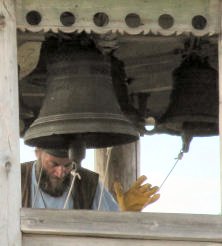
As the morning wore on, it grew quite warm. I removed my nylon pants and tied them around my waist.
As I saw them standing next to one another it occurred to me that both of our guides had dimples. I know; grow up. The farmers on the island grew oats and barley. Wheat would not grow in this location, presumably because the growing season was too short. The farmers first dried the harvested grain on racks and then in a drying barn that contained a stove. Elena explained to us the windmill that was mounted on a pivot. She told us the legend of one person was supposedly strong enough to turn it by himself. She sounded skeptical. The oldest thing on the island was the fourteenth century church of the Resurrection of Lazarus. It was brought to the island from somewhere on the eastern shore of the lake. Tests proved that the wood was from somewhere between the fourteenth and sixteenth centuries. The church had a very old design.Elena’s presentation was fine as far as it went. There was not much life in it, and at times she just seemed to be going through the motions. For her it was probably just another day at the office. Maybe I was just spoiled by the excellent tours in St. Petersburg.
After the guided tour was completed, Tom and I walked toward the part of the island that was inhabited. A soccer game was just ending there. Evidently they were able to scare up at least a couple of dozen able-bodied people. The houses were much larger than I expected, and, as Elena said, they all faced the lake.We took a very narrow path back. En route we encountered one of the other guides. A little later I actually saw a snake ahead of me on the path wiggling its way away into the high grass. Sue said later that it was probably harmless, but everything that I hve read confirmed that the only snakes on the island were vipers, which were definitely poisonous.
Jus as we arrived at the quay, we encountered Sue and Patti returning from the museum area by way of the same boardwalk that we had all used at the beginning of the tour. If I recalled correctly, they had dropped out of the tour at some point and moseyed around on their own. The ship threw a little party between the tour of Kizhi and lunch. I went up to the Sun Deck to take some pictures of our departure and enjoy a free drink. I sat in the sun, but almost all the revelers preferred the shade. The bartenders served a complimentary light-colored drink in plastic glasses. This was evidently a “Viking Bowle.” I never did discover what it contained.
As I watched them prepare to leave the harbor, I made a mental note for the first time that the crew of the Sukov wore red jumpsuits with black patches.
Galina held a Russian lesson at 11:15 a.m. The Sky Bar was full of passengers eager to learn how to speak, read, write, and understand the language. Forty-five minutes might have been just a little inadequate for the task. My objective was just to learn something. Unfortunately, most of the time was devoted to singing a couple of silly songs. She did not even provide us with the Russian words in Cyrillic. Others probably got more out of it, but I learned absolutely nothing except that the word for exit (выход) is accented on the first syllable. I made up my mind not to bother attending the second class on Sunday.
Tom, Sue, and I went to the ship’s restaurant for lunch together. Patti made a pretty regular habit of skipping one meal per day. I did not record what we ate, but the photos showed that it was pelmeni (пельмени), which are Siberian dumplings. On Friday Chef Andreas had conducted a class in which he demonstrated how to make them, but none of us had attended.Pelmeni were one of the things that I had been looking forward to trying in Russia. My guidebook said that there were lots of individuals in Moscow and St. Petersburg who sold them from carts or kiosks as fast food, but I had not seen any in St. Petersburg. The pelmeni on the ship were OK, but they were nothing special. Perhaps the most disappointing aspect of cruising was that virtually the only opportunity for interacting with the locals was in souvenir stores.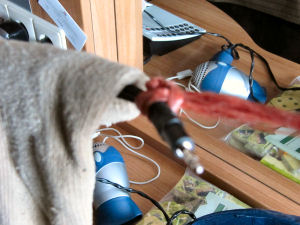
Gennady gave a lecture in the Sky Bar on the Romanovs, who ruled Russia from 1613 to 1917. The first Russian dynasty was the Rurik family, whose ancestors were the Vikings. The dynasty died out in the early 1600’s. Ivan IV (the Terrible – грозний in Russian, which is more accurately translated as “awe-inspiring”) killed his son, namesake, and heir in a fit of rage about his daughter-in-law’s comportment. His second son, Fyodor, succeeded him as czar but died without an heir. Boris Godunov, the czar’s brother-in-law, who had been the de facto ruler of Russia for years, was named the czar. The last son of Ivan IV, the boy Dimitri, was assassinated in Uglich during Boris Godunov’s reign.
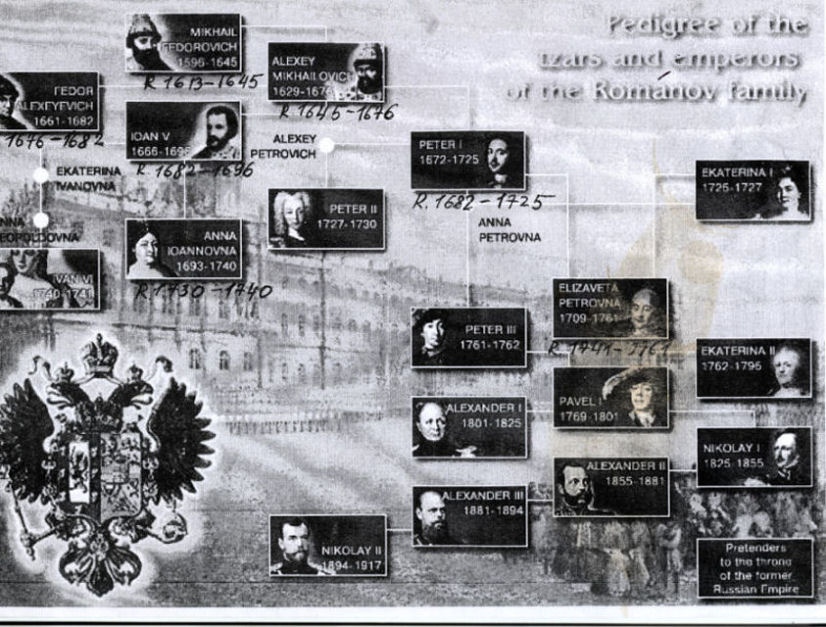
Boris Godunov death in 1605 marked the beginning of the period known as the Time of Troubles. Over the years three different men asserted that they were Ivan the Terrible’s son, Dimitri. Each claim was more preposterous that the previous one. Russia was eventually invaded by the Swedes, Tatars, Poles, and Lithuanians. The Poles actually captured Moscow and held it for a while. The city was finally liberated, and in 1613 the boyars invited Mikhail Fyodorovich Romanov, who was only sixteen years old at the time, to become the emperor. He refused several times before he was finally crowned in the Assumption Cathedral in the Kremlin and reigned for thirty-two years. Michael’s successor was his son Alexei, who reigned as the czar for thirty-one years. He was known as the “quietest.” He married twice. His first wife was a Miloslafsky; his second wife was a Naryshkin. His son Fyodor from his first wife succeeded him for six years. Then his son, Ioan I, became czar. Although he was considered feeble in both mind and body, he stayed on the throne for fourteen years before he died from unknown but suspicious causes. Alexei tried to crown his other son Peter, but the latter was more interested in sailing and his military regiment until Ioan died in 1695. Peter and Ioan were technically co-rulers for ten years, during which time Sophia served as the regent and actually ran the show.
Peter’s mother arranged for him to marry a woman named Eudoxia. Peter left her back in Russia while he backpacked through several European countries. He traveled incognito as Alexei Mikhailovich.
Sophia was involved in the Streltsy revolt in 1698. Peter fled to a monastery for his own safety. Then Peter and Sophia reconciled. While he was away, Sophia organized another revolt. Peter suppressed it, imprisoned her, and forced her to enter the convent. Sophia died there in 1707.
Peter thought that Russia needed a fleet. He built the first one in the south on the Don River in 1696. Peter attacked Sweden in 1700 in order to obtain a port on the Baltic. He ordered the construction of the city of St. Petersburg on swampy land on the Gulf of Finland and officially transferred the capital there in 1712.
Alexander Menshikov introduced Peter to Marta Skavronka, who was a prisoner of war and a Lutheran. Peter fell for her. She seemed to be able to calm down his boundless enthusiasm. They lived together, which, since Peter was still married, was a public scandal. Peter finally sent Eudoxia to a convent and married Marta, who had previously been rebaptized in the Russian Orthodox Church as Katherine. All of her male children died in infancy. Peter had his first son Alexei, whose mother was Eudoxia, executed for treason.
In 1721 Peter crowned Katherine as empress. On Peter’s death she ruled Russia for two years, but she drank too much. Menshikov amassed more and more power. He wanted one of his daughters to marry Peter’s grandson.Peter II, who was Alexei’s son, succeeded Katherine. At first he was completely under Menshikov’s influence. Later others controlled him. He also drank too much. He died after three years as czar and left no heirs.
A group of boyars invited Anna Ioannnovna to rule if she agreed to consult them on everything that she did. She agreed to this, but changed her mind as soon as she became czarina. Maybe she had her fingers crossed. At the time she had been living in poverty since the death of her husband. She was extravagant, but the other nobility underestimated her.
Anna ruled from 1730 to 1740 and then, when her health failed, she gave the crown to her grandnephew Ivan VI, who was an infant. His mother, Anna Leopoldovna, served as regent for two years.
At that point Elizabeth, the daughter of Peter I, placed the baby czar in prison and exiled his mother. Elizabeth ruled for twenty years. She was popular in the court and with the people. She was good-looking, and she really knew how to party. She owned over fifteen thousand dresses. When she died she left two silver rubles in the treasury. She never married because she feared that she would lose control of the country and, more importantly, the treasury.
Before he became czar, Peter III resided with his mother in Germany. He never liked Russia. As a teenager he was forced to wed Katherine, another German who was also a descendant of the Ruriks. The Orlov brothers helped Katherine get rid of Peter III. They proposed the plot, and she just nodded. Katherine II (the Great) then ruled Russia for thirty-four years. She spoke Russian with a slight German accent. She introduced paper money and many other reforms to Russia. Grigory Potyomkin controlled the army for Katherine and secretly married her.
Czar Paul I ruled Russia for four years, four months, and four days. He was strangled by officials in the Michael Palace, which he had had painted apricot because it matched the color of a woman’s gloves. He tried to hide behind the fire screen, but he was discovered by his assassins.
Alexander I, Paul’s son, was brought up to be the czar. His reign lasted for twenty-four years. At that point he either became a monk, or he died in the provinces. His brother Konstantin was also brought up to be the czar. He rejected the crown in order to marry a Polish woman who lacked the proper pedigree.
Nicholas I ruled for thirty years (1825-1855). He had trained to be a military officer and had no clue that he would ever become czar. He was nicknamed “Palkin,”[3] the stick. The disastrous Crimean War occurred on his watch.
Nicholas’s son Alexander II (1855-1881) was a reformer. He freed the serfs in 1861. Tens of thousands of them migrated to cities. The czar was assassinated at the site of the Church of the Savior on the Spilt Blood, which was constructed there in his memory. It was the seventh assassination attempt. Just prior to that a bomb had exploded beneath his bulletproof carriage. When he emerged from the carriage, a second assailant threw a bomb at his feet, and it eventually killed him. The terrorist group responsible for both attacks was called “People’s Will.”
The People’s Will was certainly thwarted. The slain czar’s son, Alexander III, ruled for fourteen rather regressive years.
Nicholas II was a good husband and father, but a very bad ruler. He loved to sail around the world in his yacht. He gave his wife a Fabergé egg with a replica of their yacht in it. His travels took him to Japan and England, where he met his future wife Alexandra, who was the daughter of Queen Victoria. They were distant cousins through several paths. They had four daughters and one son with hemophilia. During Nicholas’s reign Russia fought Japan in the Russo-Japanese War and lost.
On January 9, 1905, thousands of workers rose in protest in St. Petersburg. Nicholas fled to Tsarskoe Selo, and he ordered the leaders of the demonstration seized. He later set up a constitutional monarchy and finally abdicated entirely. Konstantin ruled the country for one day.[4] Then Russia was proclaimed a republic.
Vladimir Ilyich Ulyanov (a.k.a. Lenin) prepared the October rebellion. The cruiser Aurora fired a blank shot as a signal to the conspirators to begin the takeover. People who were attending the opera that evening did not even know what had happened.
The entire royal family as well as their doctor and servants were executed in Ekaterinburg in 1918.
I really enjoyed Gennady's lecture. The handout made it easy to follow along. When he was finished, I felt that I had a pretty good handle on the general trends of Russian history since 1700.
Konstantin then gave a short presentation in which he emphasized that we must decide on which tours we wish to take in Moscow. He said that when he brought his “mum” on a tour, she always went on the Sergeiev Posad Monastery and the Moscow Nights tours. I wanted to learn as much as possible about the Russian Orthodox religion. I decided that I would probably sign up for the tour of the monastery. I doubted that driving around in the dark in Moscow was likely to be something that I would savor.
The Russian Tea Time on Monday would provide Russian treats and a demonstration of how Russians use the samovar.
Konstantin also told us that the Volga-Baltic canal system was built by Czar Paul I. It was expanded by Alexander I in 1825. Then it was abandoned and then rebuilt by Stalin.
My version of the Russian supper consisted of “Stolichny Salad,” the fish soup (уха in Russian), and chicken in a sort of meatloaf. The soup was good; the chicken was just edible. I probably should have ordered the salmon, but I had already eaten a lot of fish.
On the closed-circuit television set in the cabin I watched videos of the optional Moscow tours. I was not too impressed with the portion that dealt with Sergiev Posad. In fact, the New Maiden Nunnery looked more interesting. I decided to sign up for Sergiev Posad anyway. They probably sold me when they called it the Russian Vatican. My biggest fear was that not enough people would sign up for the monastery tour. Since only fifty could go to the Military Museum, I could end up with nothing to do on Thursday in Moscow.
After supper Sue, Tom, and I played Munchkin in the Sky Bar. Sue won the first game easily. I won the second game by killing one easy monster after another.
I paid Tom back for the two beers that I owed him.
We passed through six locks overnight. The last of them was the tallest of the trip.
[1] The pattern was regular on three sides, but it was not until we went to the far side of the island that I saw the twenty-second dome.
